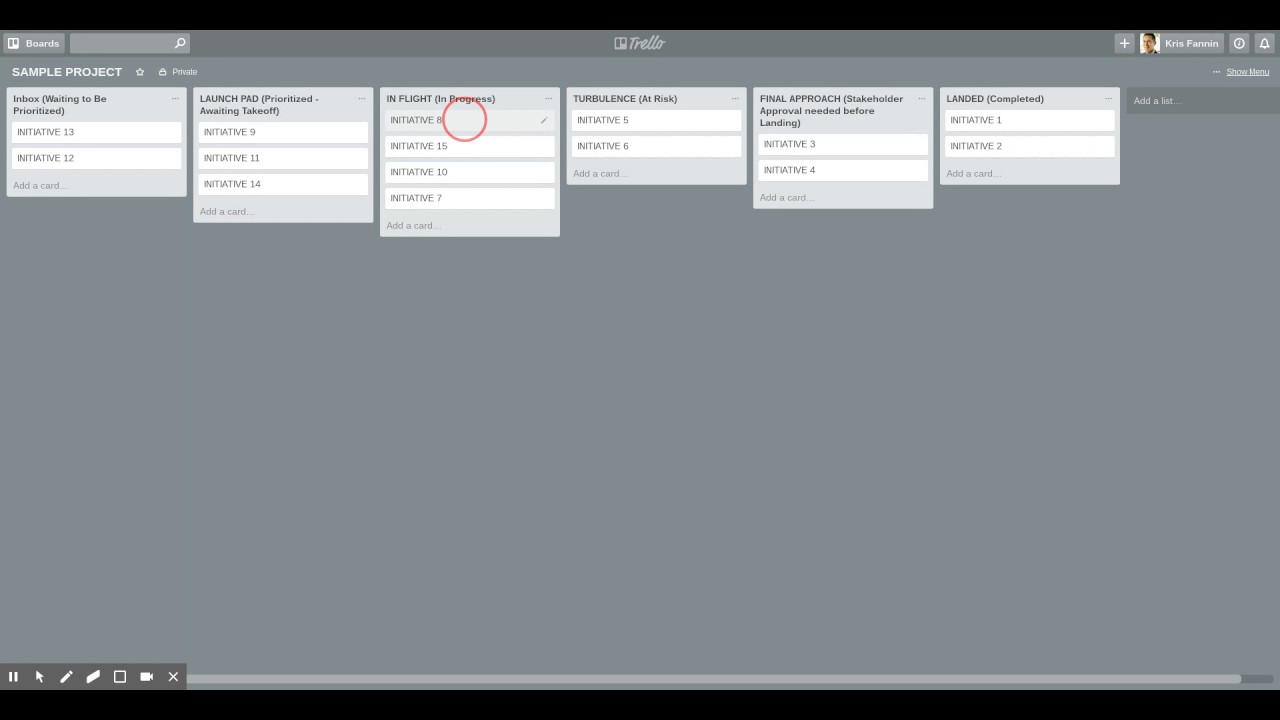Process documentation is vital for efficient business operations. Here’s Intelivate’s step-by-step guide for documenting process, including lots of process templates.
The number of businesses – large and small – I see putting themselves at risk because of a lack of documented process amazes me. Process documentation is vital to any operation. I’ll explain why in just a bit.
Because you can’t document what you don’t have, I’ll walk you through how to gather, validate and organize your process. I’ll show you how to document processes in a template I provide. You can also download all the templates I reference in this guide.
Finally, I’ll give you some tips on how to organize your project.

This is not a guide on process improvement. You must first have processes thoroughly documented before you can even consider improving them.
If you are new to the world of process, you might want to begin by reading some of our FAQs around business process management, including “What are some indications that business process might be part of my operational challenges?”
Business process documentation is complex and critical to your operation. This is an in-depth article, so you might want to bookmark this page and reference it as you go through the phases outlined below.
Let’s do this.
Why is Process Documentation Important?
Because processes are the core of your operations, documenting business process is important for many reasons including:
- Operational redundancy reduces risk in the event that key talent leaves or is unavailable.
- Business process improvement can only be done with accurate process documentation.
- Operational consistency by documenting, auditing and enforcing processes.
- Operational efficiency by reducing performance variance through operational consistency.
- Acquisition requirements often include detailed process documentation.
- Client requirements often include process documentation, especially for outsourcing in regulated industries.
- Risk mitigation to enforce and show compliance with industry requirements such as HIPAA.
- Patents and trade secrets need detailed process documentation for both filing and defense.
Documentation is one of the first areas I assess when I start working with a new B2B consulting services client. Inevitably, some of the challenges they experience are linked to process.
Business Process Documentation is Your Operational Blueprint
Would an architect or structural engineer make recommendations or changes to a building without first carefully analyzing the facts of a blueprint? No. If they made these decisions based on assumptions and not facts, the structural integrity of the building is compromised.
The same holds true when making operational decisions based on assumptions and not facts. You risk the integrity of your business operations. Here is a quick, 45-second video giving more detail on the importance of process documentation in operational decisions.
That’s the critical role of documenting business processes. It becomes the blueprint of your operations. It’s the first thing you reference when executing business change and transformation. It provides you the awareness you need to make these major decisions with confidence.
Process Documentation Approach
The approach I am going to walk you through here involves two components:
- Inventory and collect your business process
- Document and optimize your process in a structured template
Although both components are critical, how you gather your process is key to documenting. Why? If the data isn’t correct, then your process document won’t meet your goals.
Let’s start with the tools, templates, and approaches to gathering your processes.
You can’t document what you don’t have and you don’t want to reinvent the wheel. Therefore, work must occur before you document your process. These steps are:
- Develop messages and a communications plan.
- Inventory current process documentation.
- Collect process.
- Validate process.
Inventory and Collect Your Business Process
1. Develop a Process Documentation Communications Plan
Careful messaging and structured communications are critical to the success and validity of documenting your processes. You need everyone on board and providing you with accurate data.
Rumors start and spread quickly in this type of project, so be proactive in what, how, and when you communicate.
As soon as people start hearing about gathering and validating processes, teams become uneasy. Why?
- They feel like they are being audited.
- They fear they are documenting themselves out of their job.
Therefore, it is imperative to develop and execute a communications campaign for your process initiative. The specifics of the plan and the messages depend on your brand, but these are the key communications to deliver:
- Communicate why you are collecting and validating processes and how it will benefit the business, department, and individual. I like to position this as, “When you are out of the office, you people won’t bother you with questions..”
- Explain that it’s ok if the process is done differently than how it’s now documented. The business needs to know how it is actually happening. Any differences could actually lead to a new best practice!
- Reassure teams that this is not intended to reorganize or cut positions.
- Use the “Why is Process Documentation Important?“ points from above in your messages.
Here are some points on using positive transition words in your communication message to increase buy-in and participation.
2. Inventory Current Processes and Documentation
Taking the time to develop a current process inventory gives you a status of your current process documentation and provides structure for the collection phase.
If you have few or none of your processes documented, the inventory is a critical first step to define, categorize and prioritize your business process.
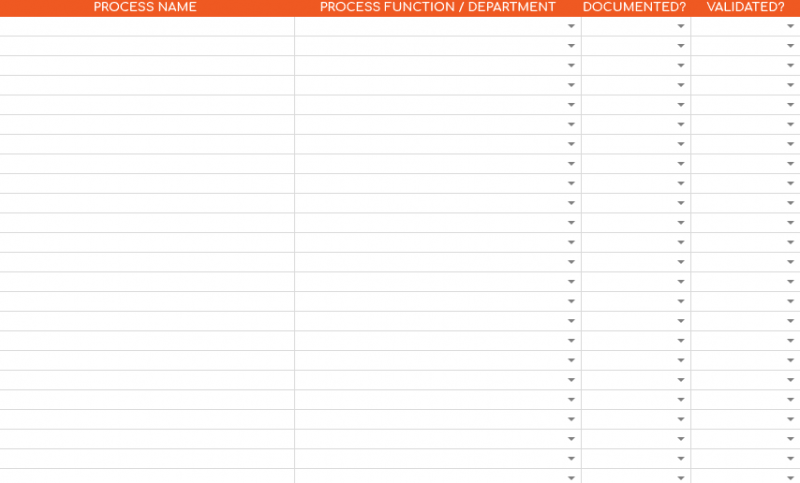
Organize your process inventory in a way that fits with your business. This template covers most needs for developing an inventory. Here’s how to use it.
Download and modification instructions are below for the Business Process Documentation Template – Input.
Process Name
Develop and enter a unique name for the process. Make the name descriptive but short. This is used throughout your documentation.
Process Function / Department
Depending on the scope of your processes, organize the function/department in a structured, category hierarchy.
For example, if you are documenting processes for a customer care call center, you organize by each defined function in the call center. This structure is important, as it dictates the structure of your document, so be thorough in capturing all related functions.
Documented?
Is the process currently documented? The input for this field is a simple ‘yes’ or ‘no.’
After you have completed your process inventory, this field gives you an idea of the level of effort required to document. Update this field as you document each process.
Validated?
Even if the process is documented, you still need to validate it. I’ll explain what process validation is and ways to do it in just a bit.
Related Process Documentation Links
Any current documentation related to the process is linked in this field. These are also supporting documents to build, document and validate the process.
Once you have documented the process, place a link to the document section here.
Notes
Related notes to the process. These include status or requirement notes.
Download and Modify the Business Process Template – Inventory Spreadsheet
- Open the Business Process Documentation Template – Inventory Spreadsheet in your browser. It’s in Google Sheets but can be downloaded in as an Excel, PDF, or .cvs file formats.
- Sign in with a Google Account to download or copy the spreadsheet. These options are available under the ‘File’ menu.
- Once you copy the process template, you can change the dropdown lists by following these simple instructions.
If you are distributing this sheet for teams to complete, don’t forget to include the “Why is process documentation important?” communication points outlined above.
3. Collect Process Details Based on the Inventory
Once you’ve completed your inventory, it’s time to collect details on processes that need documentation.
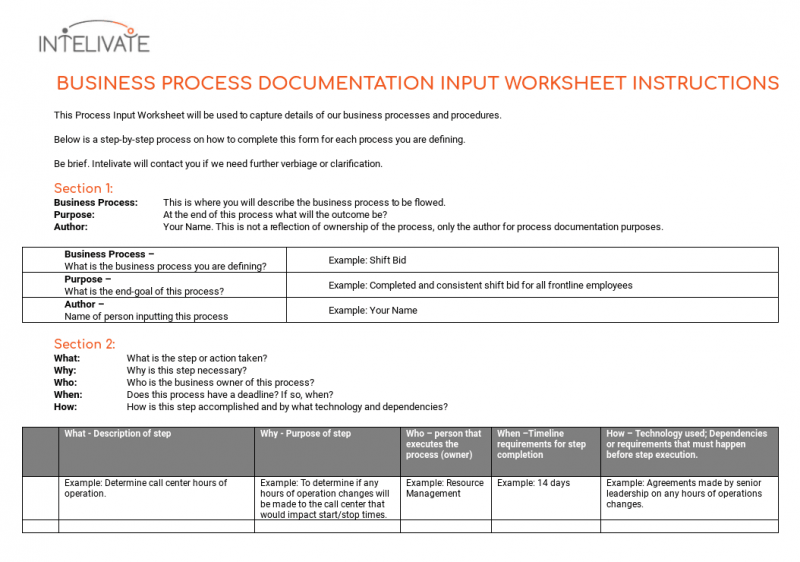
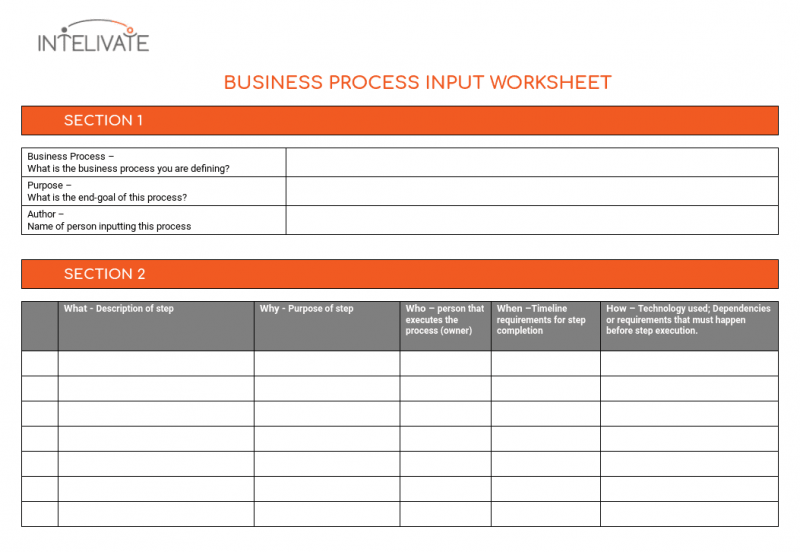
The template includes detailed instructions, so I won’t go through all of those here. You can organize and distribute this process input worksheet in a survey collection tool like Google Forms.
Regardless of how you organize and distribute the input worksheet, here are some tips for making collecting your processes effective and efficient.
- Get input from multiple people who work the process. Multiple entries allow you to find overlapping or process gaps.
- Give exact dates, times and methods for completion. People will stall. Trust me.
- Distribute and track input forms by location and/or function. If the same process occurs in multiple locations, make sure each inputs the process and records their location(s).
- Provide examples of the input to promote data accuracy and integrity. TIP! Customize the process input examples for each ‘audience’ for greater understanding and accurate input.
- Use the communication plan and messaging tips at the beginning of this article. This is critical for the input phase.
Download and Modify the Business Process Documentation Template – Input Worksheet
- Open the Business Process Documentation Template – Input Worksheet in your browser. It’s in Google Docs but can be downloaded in as Word, PDF, .rtf, .epub or .txt file formats.
- Sign in with a Google Account to download or copy the document. These options are available under the ‘File’ menu.
4. Validate Your Process Documentation
Your documentation is only as good as the data you get back. Although self-reporting is an important part of this, the data you receive must be validated. You’ll use this data to improve your process at some point, so you must be confident with the data to make these operational changes.
There are many of ways to validate processes, including:
- Shadowing involves observing each part of the process being performed. This can also be incorporated in the input phase.
- SME validation involves carefully selecting subject matter experts for the process and have them validate the accuracy of the data. Ensure these people have enough field experience to know how the process is done.
- Process gap analysis of input data for the same processes that conflict.
Process validation may seem redundant, but it’s critical for data integrity and accuracy. Remember to update and track of all validated processes in your business process documentation template inventory spreadsheet.
Now it’s time for you to take all this great data and organize it into a document or series of documents.
Process Documentation Content, Structure, and Optimization
I’m going to give you a simple, baseline structure and template to organize your processes. There are tons of tools to organize and automate much of this, but I’m going to keep this simple. If you need any suggestions around tools, let me know.
The second biggest mistake organizations make with process documents (besides not having anything documented), is making the investment and then doing nothing with it. This template structure encourages constant evaluation, updating, and providing stakeholder status of your process.
If you decide to organize and document your processes on an intranet or tool like Google Sites, you can still use the same structure I present here.
Create Two Versions of Your Process Documentation
Regardless of where you put your documentation, you’ll need two versions:
- Working version is the copy used for ongoing updates and status for your processes.
- User version is the copy used and optimized for end-users to reference during daily operations.
I’ll present the working version here. The working version is also great for explaining the process and updating stakeholders.
The user version has fewer sections.
Let’s go through each section.
1. Process Documentation Approach Summary
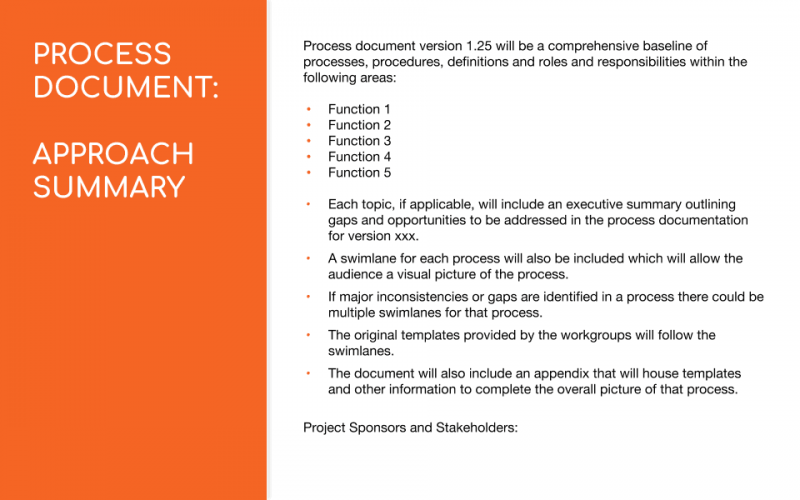
The approach summary is a short summary explanation of the overall process documentation approach. Many people are involved in the documentation, so this provides consistency in the approach.
If applicable, there is a placeholder for project sponsors and stakeholders.
2. Current Process Documentation Inventory
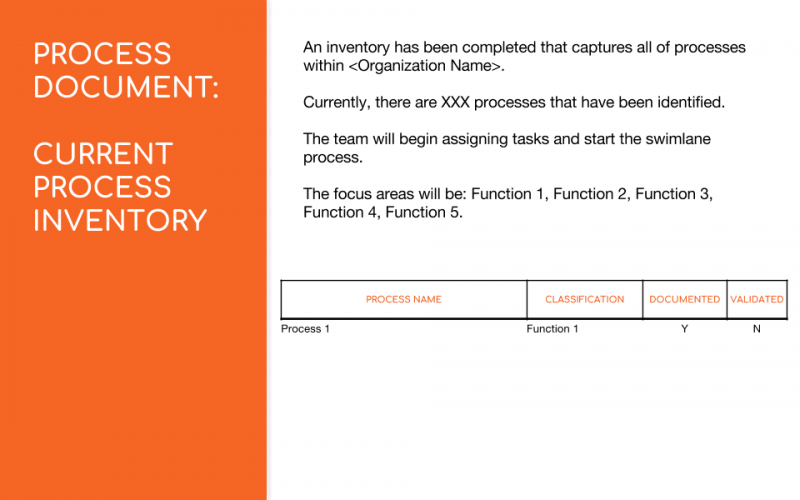
Look familiar? It should. This is the process documentation inventory you completed much earlier in the project.
This section provides a snapshot of that inventory document. Copy and paste it in this section or link back to the original inventory document.
3. Business Process Documentation Template – Input and Summary
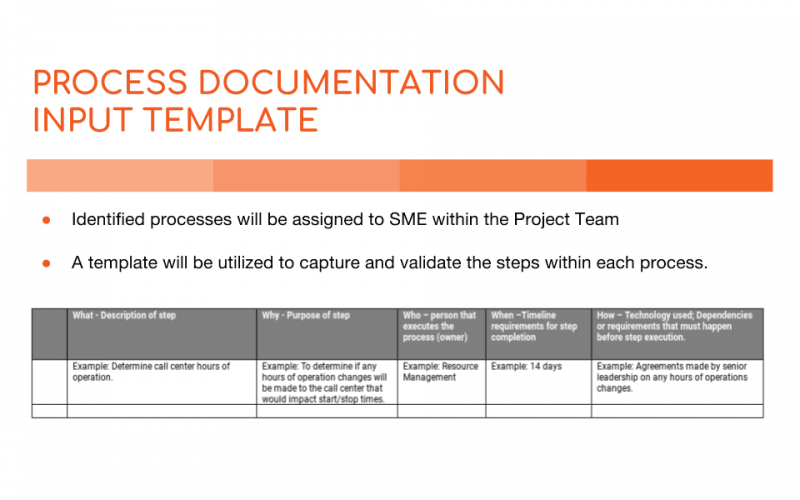
This section provides a snapshot of your process input template. Copy and paste it into this section or link back to the original input template.
4. Process Documentation Table of Contents or Directory
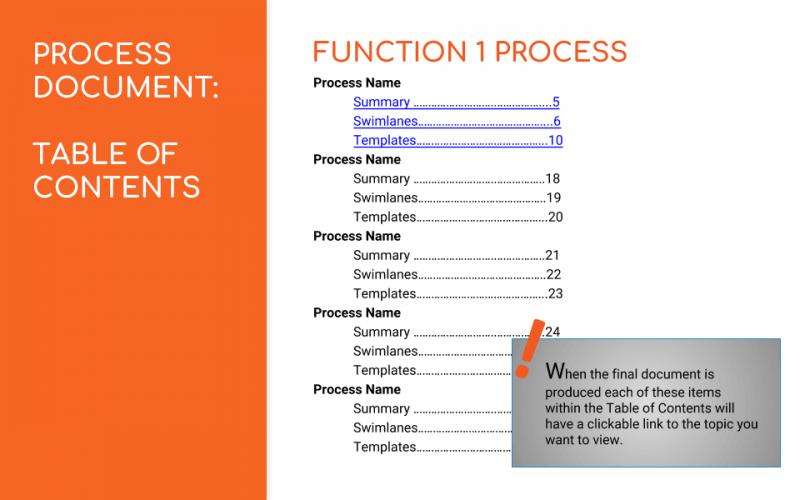
This is the first section for the end-user as well.
Remember when you defined the process categories/functions in the inventory phase? Notice how the title is by function/category. This section and the next three are completed for each category/function you defined earlier. Each related process is listed.
5. Executive Summary / Process Gap Analysis Findings
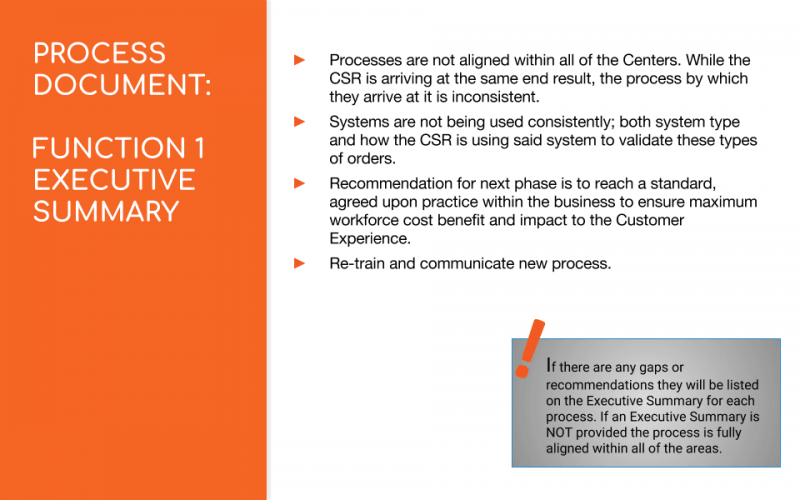
Summarize any gaps, redundancy or recommendations for each process function in this section. These were identified during the process input and validation phases.
6. Process Swimlane Diagram
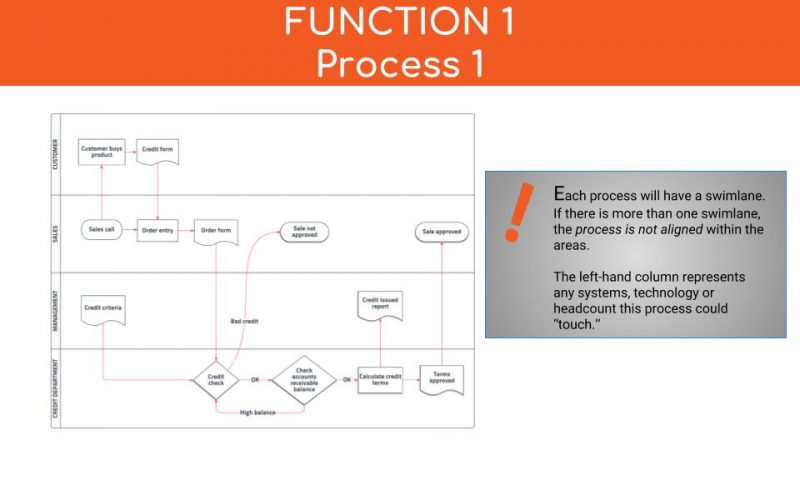
Each process will have a swimlane. If there is more than one swimlane, the process is not aligned.
The left-hand column represents any systems, technology or headcount this process could “touch.”
What is a Swimlane Diagram?
A swimlane diagram is a visual representation of a processes steps, dependencies, resource requirements and result.
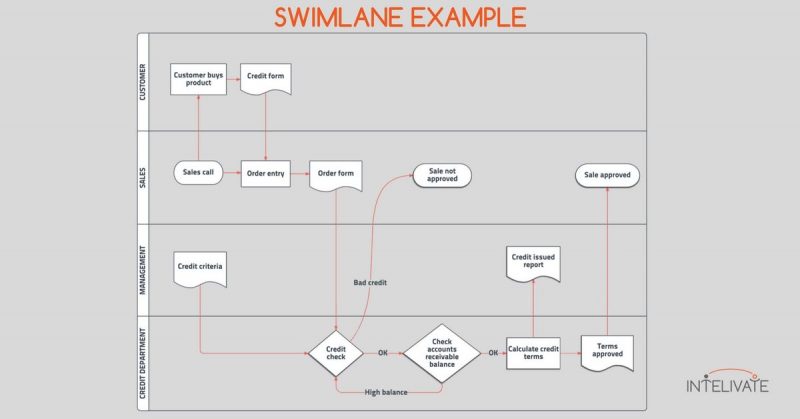
Why is a Process Swimlane Diagram Important?
There are several benefits to a swimlane diagram including:
- Faster and easier comprehension of complex processes.
- Process gap and improvement analysis.
- Process simulation depending on the tool.
- Linking processes and dependencies.
- Identify both under and over-utilized resources and technologies.
- Identify operational bottlenecks and slowdowns.
How to Develop a Swimlane Diagram
I recommend tools like Visio and Lucidchart for most swimlane diagrams. There are many process automation tools that have dynamically built swimlane diagrams.
- Access your validated data from the process documentation input worksheet.
- Consolidate the “Who” and “How” data. This is your left-hand column in the swimlane.
- The “What” data is each step in the process and mapped along the “Who” and “How” column.
- Although you can put timelines in a swimlane document, unless regulation requires them, I prefer to keep it visually simple.
7. Completed and Validated Process Documentation Input Data
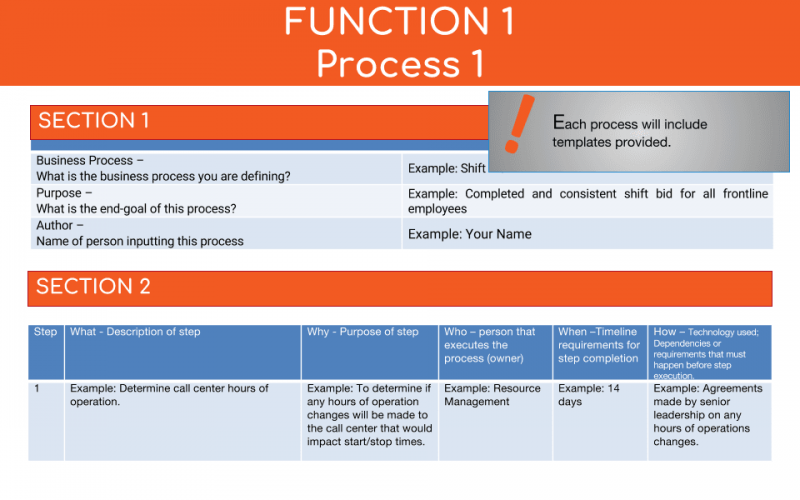
This section provides a snapshot of the completed and validated process input data. Copy and paste it in this section or link back to the original input document.
8. Process Recommendations and Action Items
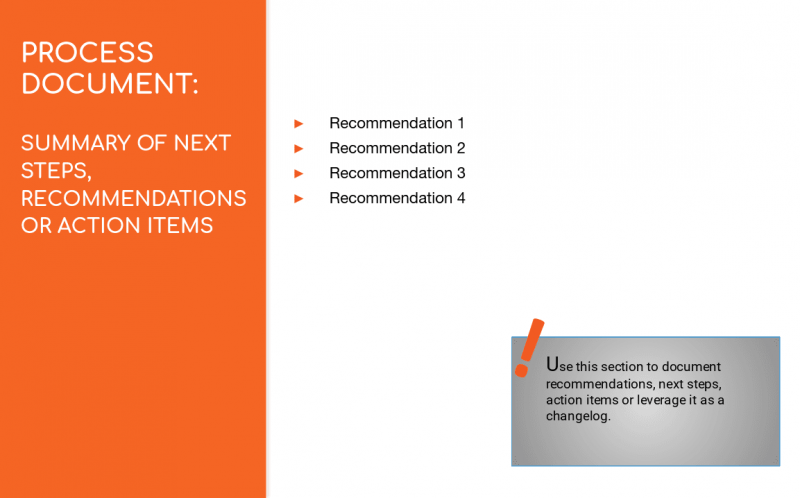
Use this section to document recommendations, next steps, action items or leverage it as a changelog. I highly recommend assigning and tracking these tasks in a project management tool. I’ll give you some tips on organizing your process project in a bit.
Download and Modify the Business Process Documentation Template
- Open the Business Process Documentation Template in your browser. It’s in Google Slides but can be downloaded in as PowerPoint, PDF, or image file formats.
- Sign in with a Google Account to download or copy the template. These options are available under the ‘File’ menu.
- Alternatively, you can go to my Slideshare profile and download the same business process documentation template there.
9. Optimize Business Process Documentation for End Users
Documenting your process has little impact if people don’t know where to reference the information, it isn’t easily accessible or understandable. Therefore, you want to make sure you optimize the documentation.
Although optimization methods depend on where you keep your process documentation and how it’s organized, here are some tips:
- As I noted earlier in the process inventory phase, take the time to build a solid hierarchy and structure of your process categories/functions.
- Develop a tagging structure to link processes, steps, and dependencies, especially if you store process documentation online.
- Hyperlink processes, steps, and dependencies for easy reference.
- Target the language and structure for the intended audience of the process documentation.
- Don’t use process documentation directly for training. Although process documentation must the basis of training material development, it shouldn’t be the training material itself.
- Develop visual job aids and infographics for your teams to reference daily. You can see a process infographic we use to support our communications process and effective collaboration.
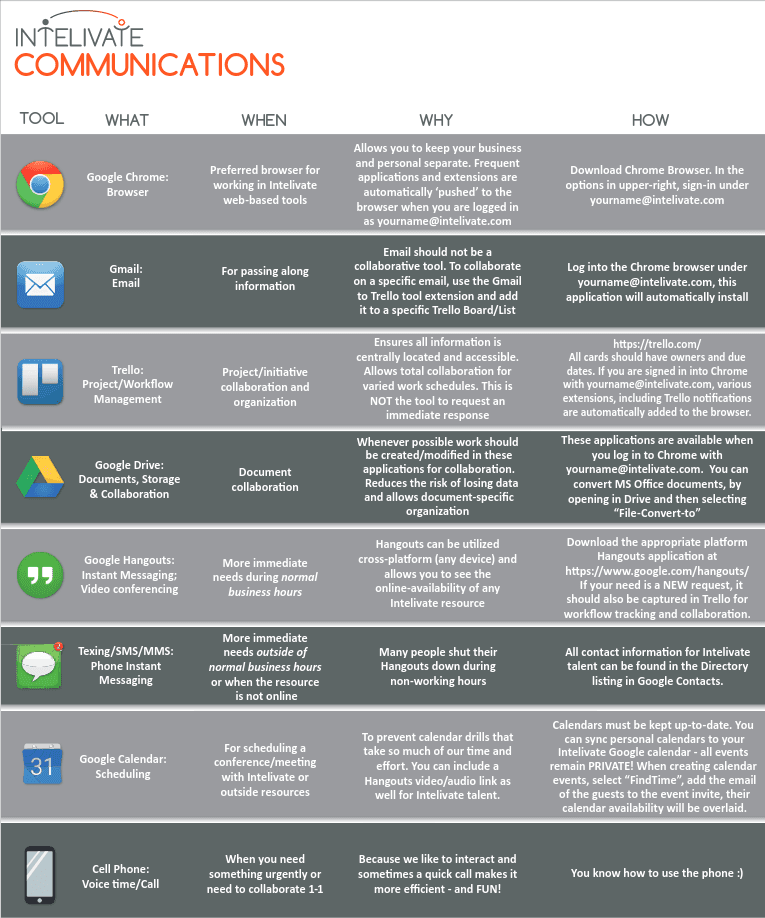
Organizing Your Process Documentation Project
I left this for last, as you need to be familiar with the templates and data before I give you tips on how to organize your project.
I like to keep things as simple as possible, even with something as complex as documenting business processes. Here is the approach we use for project organization and task tracking.
Depending on the scope and number of processes, you can use the same list categories I outlined to organize your project. Each card would represent a process. Assign any person involved with the process to the card.
You can use color-coded labels to represent each documentation phase or make separate projects for each phase.
Alternatively, each list can represent each phase of your process documentation project.
You could even use Trello as the central repository of your process documentation! However, keep two separate boards:
- One for ongoing process work,
- One for end-user search and reference.
Just keep it simple and usable. That’s key in organizing your project as people must stay engaged to keep your process documentation a living part of your operation. Remember, it’s now your operational blueprint.
Consider a Phased Approach to Documenting Process
For large-scale documentation projects, I recommend a phased approach. There are many ways to organize this but start with a pilot until you get everything down to near-perfect. At that point, phase the process documentation project out to more parts of the organization.
Additional Business Process Documentation Pointers
Remember when I said that business process documentation was complex? I’ve given you a lot here and hope it sets you up for success in your initiative.
Here are a few pointers and reminders:
- Bookmark and reference this as you go through each phase of documentation. You don’t need to do it all at once.
- Don’t forget to build a communications plan. That is critical to making your initiative a success.
- Remember, every organization is different. There are countless ways to document processes. Don’t think that you can’t or shouldn’t customize the approach I outlined here.
- This process is ongoing. Don’t document and then forget about it.
- Check back soon (or subscribe above), as I’ll publish an article on the next step – improving the processes you documented.
Don’t hesitate to let me know if you have any questions or need any clarifications. You can find me on Twitter.
Good luck with your process documentation and know you are making a critical investment in the business!
Related Solutions to Help You With Business Process Documentation and Improvement
Kris Fannin
Kris Fannin is a passionate change agent in workforce transformation. For more than 25 years, he's had the privilege of partnering with dozens of client organizations and leading hundreds of teams to become powerful influencers.
"Your legacy will be defined by the passion and impact of the people you influence. What do you want your legacy to be?"

